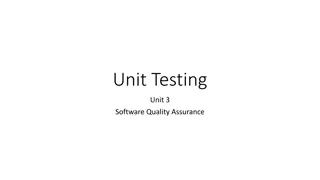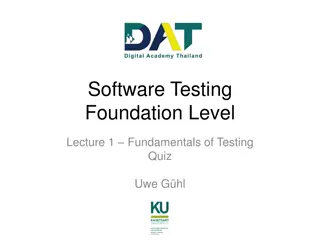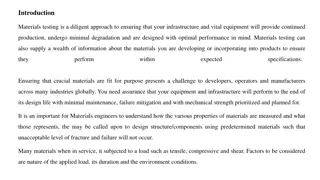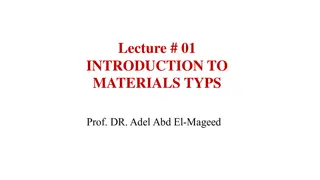Understanding Impact Testing for Materials Evaluation
Impact testing is crucial for assessing the toughness and resistance of materials to fracture under high-rate loading conditions. Charpy and Izod tests are common methods used to measure impact energy and evaluate materials' performance. The tests involve striking a specimen with a striker and measuring the energy absorbed before fracture occurs. By analyzing the impact energy and fracture characteristics, manufacturers can ensure the quality and reliability of materials in various applications.
Download Presentation

Please find below an Image/Link to download the presentation.
The content on the website is provided AS IS for your information and personal use only. It may not be sold, licensed, or shared on other websites without obtaining consent from the author. Download presentation by click this link. If you encounter any issues during the download, it is possible that the publisher has removed the file from their server.
E N D
Presentation Transcript
Impact test The purpose of impact testing is to measure an object's ability to resist high-rate loading. The test measures the impact energy, or the energy absorbed prior to fracture. What is Impact Energy? Impact energy is a measure of the toughness of a materials, i.e. materials resistance to fracture. When the striker impacts the specimen, the specimen will absorb energy until it yields. At this point, the specimen will begin to undergo plastic deformation at the notch. The test specimen continues to absorb energy at the plastic zone at the notch. When the specimen can absorb no more energy, fracture occurs. The most common methods of measuring impact energy are the: Charpy Test Izod Test The Charpy Test While most commonly used on metals, it is also used on polymers, ceramics and composites. The Charpy test is most commonly used to evaluate the relative toughness or impact toughness of materials and as such is often used in quality control applications where it is a fast and economical test
Charpy Test Specimens According to ASTM Standard E 23, Standard Test Methods for Notched Bar Impact Testing of Metallic Materials , Charpy test specimens normally measure 55x10x10mm and have a notch machined across one of the larger faces. The notches may be: V-notch A V-shaped notch, 2mm deep, with 45 angle and 0.25mm radius along the base U-notch or keyhole notch A 5mm deep notch with 1mm radius at the base of the notch. Figure (1) Standard specimens of Charpy and Izod impact energy tests
Figure 3. Schematic of the Charpy specimen impact test. Figure 2. Schematic of the Charpy impact test.
What Does the Charpy Test Involve? The Charpy test involves striking a suitable test piece with a striker, mounted at the end of a pendulum. The test piece is fixed in place at both ends and the striker impacts the test piece immediately behind a machined notch. Determination of Charpy Impact Energy At the point of impact, the striker has a known amount of kinetic energy. The impact energy is calculated based on the difference between initial and final heights of the swinging pendulum. Impact energy (E) = mgh1- mgh2 = mg ( h1-h2) Energy unit is Joule = N.m h unit is m g is gravity ( 9.8 N/Kg or m/s2 ) m unit (Kg) Note: Tough materials absorb a lot of energy, whilst brittle materials tend to absorb very little energy prior to fracture
B A Figure 4. A- Brittle and B- ductile fracture under Charpy impact test The left specimen brittle looks like it just snapped in half. The right specimen sample is ductile and bends without breaking into pieces.
The main differences between Izod and Charpy Izod and Charpy tests are similar, but they are different in : 1. Point of Strike : : Point at which the hammer strike the specimen is different for both of them. In Izod test hammer strike at the upper tip of specimen while in Charpy test hammer strike at point of notch but in opposite direction 2- Direction of Notch: : Face of specimen which faces the striker is different. The notch face in the izod test is facing the striker, fastened in a pendulum, while in the charpy test, the notch face is positioned away from the striker. 3-Type Of Notch:In hardness testing two types of notches are used V-notch and U-notch. In the Charpy method, there are two kinds of notches, the V-notch and the U-notch, while in the Izod method, there is V-notch is used 4-Specimen Dimensions: : Even if you are testing the same material the test specimens have different dimensions for each test. The basic Izod test specimen is 75 x 10 x 10mm, the basic Charpy test specimen is 55 x 10 x 10mm. CHARPY TEST IZOD TEST
Factors Affecting Charpy Impact Energy Factors that affect the Charpy impact energy of a specimen will include: 1- Yield Strength and Ductility: For a given material the impact energy will be seen to decrease if the yield strength is increased due to the reduction of ductility 2-Notches: The notch serves as a stress concentration zone and some materials are more sensitive towards notches than others. The notch depth and tip radius are therefore very important. 3- Temperature and Strain Rate: The higher strain rate, the lower impact energy
Ductile to Brittle Transition for metals Body centered cube materials such as carbon steels undergo what is known as a ductile to brittle transition . This behavior is obvious when impact energy is plotted as a function of temperature. FCC metals do not have a ductile to brittle transition temperature and instead remain ductile at low temperatures. This is because the stress required to move dislocations is not strongly temperature-dependent in FCC metals, and thus failure occurs by plastic flow instead of crack propagation. In BCC metals, at low temperature the stress required to make crack propagation is less than stress required for plastic flow, thus failure occurs by crack propagation. Examples of Materials which have FCC structure are: Aluminum, Nickel, Copper, austenite (Gamma-Iron) Examples of Materials which have BCC structure are: Pure Iron, Chromium, (alpha, delta Iron)
Figure 6. Ductile to Brittle transition of BCC materials at low temperature
Figure 7. Effect of Temperature on materials with FCC and BCC structure
Example: Following is tabulated data that were gathered from a series of Charpy impact tests on a tempered 4340 steel alloy Temperature (c) Impact Energy (J) 0 105 _25 104 _50 103 _75 97 _100 63 _113 40 _125 34 _150 28 _175 25 _200 24 (a) Plot the data as impact energy versus temperature. (b) Determine a ductile-to-brittle transition temperature as that temperature corresponding to the average of the maximum and minimum impact energies. (a) Determine a ductile-to-brittle transition temperature as that temperature at which the impact energy is 50 J
120 110 100 90 80 70 B energy J 60 50 40 30 20 C 10 0 -250 -200 -150 -100 -50 0 temperature C Solution: (b) Average maximum and minimum impact energies = 24+105 / 2 = 64.5 J So, temperature at 64.5 J is equal to about - 99 C ( c ) a ductile-to-brittle transition temperature as that temperature at which the impact energy is 50 J is about T= -110 C























